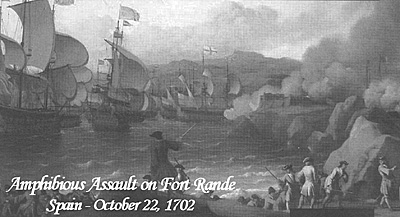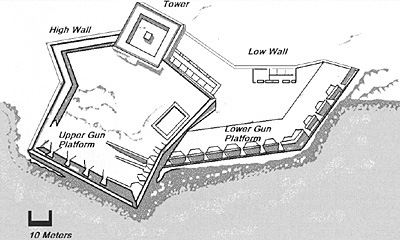 Gamers conjure up visions of hoards of multicolored troops when the War of the Spanish Succession is brought up, many having heard of Blenheim, Ramillies, Oudenard and Malplaquet. However, there were a number of smaller, less well-known battles and skirmishes that lend themselves to great wargames. The battle of Vigo Bay is often discussed as a major naval victory, but its history often glosses over a very important amphibious landing that made it possible.
Gamers conjure up visions of hoards of multicolored troops when the War of the Spanish Succession is brought up, many having heard of Blenheim, Ramillies, Oudenard and Malplaquet. However, there were a number of smaller, less well-known battles and skirmishes that lend themselves to great wargames. The battle of Vigo Bay is often discussed as a major naval victory, but its history often glosses over a very important amphibious landing that made it possible.
The Attack on Fort Rande a contemporary painting by Ludolf Bakhuizen.
In July 1702, Spanish Treasure Galleons were returning from the Caribbean, their holds filled with millions of dollars in gold and silver to fill the coffers of Philip V of Spain.
The galleons were protected by 15 French men of war carrying 929 guns under Admiral de Château-Renault and by 15 Spanish men of war with 178 guns under Admiral Don Manuel de Velasco. A fast Spanish frigate sailing ahead of the treasure fleet entered Seville and learned that France and Spain were at war with the Grand Alliance over the succession of the Spanish Crown. Cadiz, the fleet’s destination was under attack by an Anglo Dutch fleet under Admiral George Rooke.
Unwilling to risk the loss of their treasure galleons, the treasure fleet diverted to Vigo, just north of the Portuguese border. Vigo was a small, walled fishing town situated on the edge of one of the safest and deepest harbors in Spain, surrounded by the Gallician hills. Just beyond Vigo, in the Bay of Redondela, the entrance of the harbor narrowed to a third of a mile. Anchoring the fleet in the harbor beyond this natural defile, Château-Renault built a large floating boom across the entrance to the harbor. A man of war was tethered to each end of the boom, and another five were position behind it with their broadsides facing the harbor entrance. On either side of the harbor entrance was a fortress, the largest, Fort Rande, was on the south side and had an artillery platform with 38 cannon.
Admiral Rooke by a fortuitous piece of intelligence, learned that the treasure fleet was at Vigo. In October, Rooke’s fleet sailed to Vigo and approached the entrance to the harbor.
In order to ease the passage of the fleet, it was decided that an attack should be made by land to seize the forts. The larger attack would be on the south entrance of the harbor against fort Rande. Six miles past Vigo, a sandy beach was discovered to be suitable for a landing.
Under the command of the Duke of Ormond, the landing force made their way across the coastal hills until they were in sight of the fort. A Redondela carpenter, Domingo Martinez, witnessed battle. This previously unpublished account surfaced in 1946. The Battle of Rande. Revist General de Marina Tomo 130, January (1946)
“...between eleven and twelve during the day, when it was almost time for full tide, at the site of Teis, up to 4,000 English disembarked and moved directly to Fort Rande, and our troops stood their ground being in view of Principe de Barbanzón, Governor of the Kingdom (of Galicia), with most of the nobility, many of the Militia and eight companies of horse... and here came the English without firing powder or shot at Rande... those of the landing took to Fort Rande and the Militia deserted leaving only the French Artillerymen, up to 200, and some Andalusians many of whom died when a bomb thrown by the ships exploded causing great damage and destroying some of the forts artillery... the English entered the fort hoisting their standard and those at sea saw that the fort had been captured, they (the English in the fort then) bombarded Fort Corbeiro (across the straight) and (French and Spanish) ships with the (captured) artillery... “
The English were in two brigades, the first under Brigadier Hamilton, the second under Brigadiers Portmore and Lloyd. There was also a Dutch Brigade of undetermined composition led by Baron Spaar. The exact number of English and Dutch is hard to determine. Burchett in his Impartial Account of the Material Transactions of the Grand Fleet and Land Forces - 1703 Describes the Dutch as being present, and other uncited sources reproduced by James Grant - British Battles - Volume 1 (1823) identify actions of individual Dutch officers.
The van of the Anglo Dutch assault was a detachment of the Coldstream Guards and a unit made of Grenadiers that had been detached from their parent battalions and converged into a single ad hoc battalion for the assault on the fort.
 Churchill’s regiment followed to the left with the rest of the first brigade. As the van crested the rocky hills before the fort, several thousand militia under the command of Prince de Brabançon met them. Burchett claims 20,000, but as there were only 10,000 men assigned to the area, a number of 8,000 is more credible, and as previously noted, Domingo Martinez describes 8 companies of horse.
Churchill’s regiment followed to the left with the rest of the first brigade. As the van crested the rocky hills before the fort, several thousand militia under the command of Prince de Brabançon met them. Burchett claims 20,000, but as there were only 10,000 men assigned to the area, a number of 8,000 is more credible, and as previously noted, Domingo Martinez describes 8 companies of horse.
The militia immediately began an undisciplined fire at the English as soon as they came into view, but their range was too great and the fire ineffective. The Guards and Grenadiers responded with an immediate bayonet charge led by Lord Shannon. The militia began to give way. Churchill’s regiment advanced on the left and began firing into the militia driving them back onto the fort until the majority of them broke and ran.
Several of the Spanish militia fell back into the fort and reinforced the 300 French marines and sailors within.
“..we attacked and (were) met with a vigorous opposition, but our men, so boldly pressing forward, made themselves masters of the battery and trenches, and the enemy to retreat, although they had at least 20,000 in and near this place, yet dares not engage us, because they saw the resolution of our forces.”
The Grenadiers made good use of their grenades making it difficult for the French and Spanish to fire into the attacking English.
Meanwhile, the ships of the Anglo Dutch fleets had been advancing on the boom and were taking fire from Fort Rande and from the 17 cannon of fort Corbeiro across the straight on the north side. The ships of the fleet returned fire into the forts.
“ When the ships began to batter the forts, the troops were advanced up to the very walls of the fort on the south side; and the soldiers getting up on each others backs till they mounted the top of the wall, and leaped down into the fort, and took it immediately sword in hand.”
The French and Spanish fell back into the old stone tower. Monsieur de Sorel, captain of the French garrison opened the gates, sword in hand, with the intention of charging out at the head of his men to repel the English. However, this act was met by a bayonet charge of the Grenadiers and Guards and the garrison finally capitulated.
The guns of Rande were trained on fort Corbeiro across the straight and onto the French and Spanish ships behind the boom. The redcoats swarmed the ramparts and the English flag was hoisted above the fort, a loud jubilant cry rose from the fleet. The floating barrier was rammed and broken by the Torbay.
A number of the militia and French were cut off on the right and tried to swim to freedom, but were cut down in the water by the Dutch.
The fort in enemy hands, and the boom breached, the French and Spanish set fire to their ships, but the English and Dutch captured several of the treasure galleons.
This was a major victory for the Alliance and although much of the treasure had been unloaded the engagements made the fortunes of many captains. The battle of Vigo Bay, as it is known, is well documented. What is less precisely documented is the land action and attack upon Fort Rande. The capture of the forts on either side of the narrow passage into the harbor was instrumental in the destruction of the Franco Spanish fleet.
Bibliography and Sources
The Journal of Sir George Rooke, Admiral of the Fleet, 1700-1702 (edited by Oscar Browning)
An Impartial Account of all the Material Transactions of the Grand Fleet and Land Forces (1703). Burchett. Page 22
Nette Afteykeningh van het Veroveren der France en Spanse scheepen inde Bay van Vigos door de Engelsche en Hollande Vloot: den 22 Octo. 1702. Hand colored plate engraving. (Extraído do Catálogo da exposición da colección Puertas-Mosquera, Santiago 2000)
Story of Domingo Martinez, carpenter of Redondela witness of the battle. In Filgueira Valverde. An unpublished account of the Battle of Rande. Revist General de Marina Tomo 130, January 1946)
The battle of Vigo Bay, 1702. Painting by Ludolf Bakhuizen. Bakhuizen, a Dutch painter famous for his naval scenes died in 1708
British Battles - Volume 1 James Grant (1823 - 1880)
Caarte vande Bay en have van Vigos, en vant veroveeren der Franceschcpen en spaanse galioenen door de geconbineerde flote. Feito por Jan Van Call. Gravado holandés 1702-1717. (Extraído do Catálogo da exposición da colección Puertas Mosquera, Santiago 2000)
A Voyage to Cadiz in the Grand Fleet under Sir George Rook in 1702... The Voyages and Travels of Captain Nathaniel Uring, 1726 (aboard the St. George)
Milicias provinciales galegas e granadeiro de Mondoñedo, 1702. Debuxo de M. Montaner. Published in Defensa, nº 109 de 1987.
The Spanish Army of Philip V, 1987. James Hind
Het Staatsche Leger, Deel VIII, Band 1 page 202
Special thanks to Dan Schorr for his help with the Dutch OB and Daniel Bode for translating the Spanish accounts.
Assault on Fort Rande: The Wargame
Related:
Platoon Fire: War of the Spanish Succession {TC 90]
Back to Table of Contents -- Courier # 91
To Courier List of Issues
To MagWeb Master Magazine List
© Copyright 2004 by The Courier Publishing Company.
This article appears in MagWeb.com (Magazine Web) on the Internet World Wide Web.
Other articles from military history and related magazines are available at http://www.magweb.com